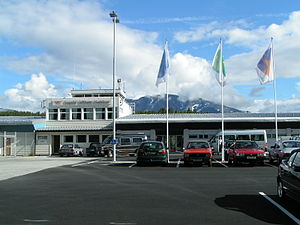Sogndal Airport, Haukåsen
|
Sogndal Airport, Haukåsen Sogndal lufthavn, Haukåsen |
|||||||||||
|---|---|---|---|---|---|---|---|---|---|---|---|
 |
|||||||||||
| Summary | |||||||||||
| Airport type | Public | ||||||||||
| Owner/Operator | Avinor | ||||||||||
| Serves | Sogndal, Norway | ||||||||||
| Location | Haukåsen, Sogndal | ||||||||||
| Elevation AMSL | 498 m / 1,633 ft | ||||||||||
| Coordinates | 61°09′26″N 007°08′17″E / 61.15722°N 7.13806°ECoordinates: 61°09′26″N 007°08′17″E / 61.15722°N 7.13806°E | ||||||||||
| Website | Official website | ||||||||||
| Map | |||||||||||
| Location in Norway | |||||||||||
| Runways | |||||||||||
|
|||||||||||
| Statistics (2014) | |||||||||||
|
|||||||||||
|
Source:
|
|||||||||||
| Passengers | 70,244 |
|---|---|
| Aircraft movements | 5,735 |
| Cargo (tonnes) | 5 |
Sogndal Airport, Haukåsen (Norwegian: Sogndal lufthavn, Haukåsen; IATA: SOG, ICAO: ENSG) is a regional airport serving Sogndal, Norway. It is situated at Haukåsen, 10 kilometers (6.2 mi) from Kaupanger and 20 kilometers (12 mi) from Sogndalsfjøra. It serves the Sogn district. The airport consists of a 1,180-meter (3,870 ft) runway aligned 06/24. Services are provided by Widerøe on public service obligation with the Ministry of Transport and Communications. The airport is owned and operated by the state-owned Avinor and served 70,244 passengers in 2014.
The airport opened on 1 July 1971 along with three other regional airports in Sogn og Fjordane and Sunnmøre. These were at first connected to Bergen and Ålesund using the de Havilland Canada DHC-6 Twin Otter. From the 1980s the airport was upgraded and de Havilland Canada Dash 7 started being used, allowing all-year services to Oslo.
A government commission, led by Erik Himle and later Preben Munthe, was appointed in 1962 to consider additional airports in Norway. The Sud Aviation Caravelle was about to the phased into use on the main domestic routes and the committee recommended in 1964 that nine new airports be built which could serve jetliners, including an airport in Florø to serve Sogn og Fjordane. Widerøe launched an alternative proposal and suggested that a network of smaller airports be built instead, which could be served using short take-off and landing aircraft, which were being developed at the time. Smaller airports could be built and operated at lower cost than larger airports, but both airports and airlines would need subsidies to operate. Håkon Kyllingmark was appointed Minister of Transport and Communications in 1965 and was a proponent of the STOLport proposal. The political rationale was that, despite that the total operating costs would rise, it would provide better services to rural areas and thus keep up their population.
...
Wikipedia

